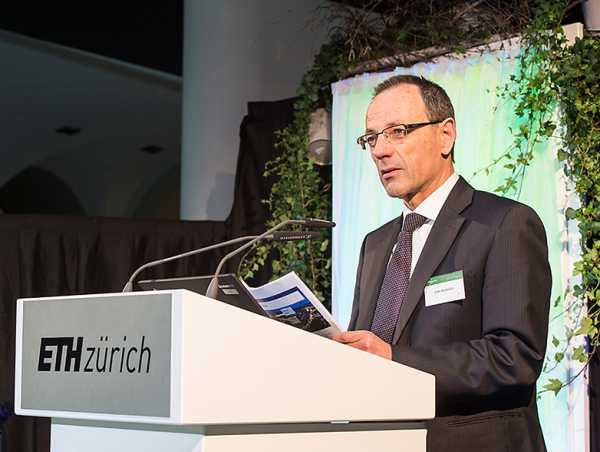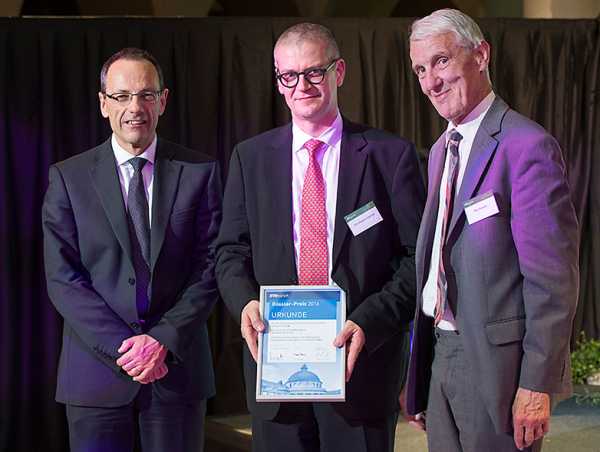An obsession with surfaces
The winner of the Max Rössler Prize 2016 is Christophe Copéret. The chemist focuses on the design of functional materials via a molecular approach, such as solid catalysts, derivatization of microelectronic devices, and developing new imaging techniques to visualise individual particles or track metabolites in the human body.

“This comes as a complete surprise,” confesses Professor Christophe Copéret. “Never would I have imagined to win this award.” No one spoke to him about the Max Rössler Prize, or mentioned a possible nomination. He is this year’s winner: ETH President Lino Guzzella presented the Max Rössler Prize 2016 to the chemist on Wednesday.
The professor was a very good choice in the eyes of Detlef Günther, Vice President Research and Corporate Relations and a member of the jury. “As far as the jury was concerned, Christophe Copéret stood out as a highly creative and versatile researcher in the field of inorganic chemistry. I am particularly pleased to see this prize go to him as a surface chemist, as this is an area of research I also follow closely”, commented Professor Günther.
Professor Copéret is deeply committed and engaged in a very broad area of research, yet manages to stay incredibly focused, he continued. “On top of that, he is a great networker and makes a special effort to promote collaboration with international colleagues in his field.”
The prize sponsor, Max Rössler, added: “I am delighted to see the prize go to such a dedicated researcher. He shows exceptional creativity and passion for his subject.”
Max Roessler Prize 2016 - Award ceremony




A fascination for lab coats
Professor Copéret has won around a dozen academic prizes over the course of his career, but none quite as remunerative as the Rössler Prize. The 46-year-old professor will receive 200,000 Swiss francs in prize money. He still hasn’t given much thought about what to do with the cash. “Its main benefit will be to fund future research and educational projects.”
Professor Copéret was raised in Fleurie, a village in the French wine-growing region of Beaujolais. His parents run a small carpentry business, but he was drawn to a different career path at quite an early age, becoming interested in chemistry as a profession even as a boy. His first experiment was monitoring the fermentation of wine with his grandfather (a wine maker), a chromatographic measurement.
He recalls two key events that pulled him in that direction: at the age of nine, he read a children’s book about different occupations and the requirements needed to work in them. He was especially fascinated by two of the professions presented in the book: petrochemist and chemical engineer. “The people dressed in white lab coats and the striking coloured test tubes shown in this book made a particularly strong impression on me”, he recalls.
The next thing to fire his interest in chemistry was an article about American universities published in the magazine GEO. After reading this, the young boy was definitively hooked: “I wanted to study chemistry and explore other continents.”
Lyon – USA – Lyon – Zurich
And that’s exactly what he did. He moved to Lyon to study chemistry and chemical technology. To complete his engineering degree, he joined Purdue University (West Lafayette, Indiana) in 1991, as a graduate student. After finishing his PhD in 1996, with Prof. Ei-ichi Negishi (Nobel Prize in Chemistry, 2010), he then worked as a postdoctoral researcher at the Scripps Institute in La Jolla, California, under the guidance of Professor K. Barry Sharpless (Nobel Prize in Chemistry, 2001).
His love of chemistry then drew Professor Copéret back to Lyon. “The magic of surface chemistry was my main reason for returning to France”, he says. He started there as a Chargé de Recherches in the Laboratory of Surface Organometallic Chemistry from the Centre National de la Recherche Scientifique (CNRS). He rapidly completed his habilitation thesis in 2002 and was promoted CNRS Research Director in 2008. In 2010 he was appointed Professor of Surface & Interfacial Chemistry at ETH Zurich.
ETH – a special place
He was thrilled when he received the appointment at ETH Zurich. “Moving to ETH Zurich was a major turning point in my research career”, Copéret affirms. “This university is an unique and incredible place. I am surrounded by open minded and talented people, motivated students and colleagues – and I also enjoy a high degree of academic freedom.” ETH is a community inspired by mutual trust, where the only constraints are the limits of your own mind.
Professor Copéret thinks it is important asset for ETH Zurich to remain an efficient institution. Administrative work should be kept to a minimum. “Too much bureaucracy kills creativity and entrepreneurship”. We need to make ETH a place where people, faculties and our students, devote their time to bending the boundaries of science and pushing through them.”
Surface chemistry: not unlike a jigsaw
One particular focus of Professor Copéret’s research is heterogeneous catalysis, a pillar of efficient processes. Heterogeneous catalyst and the reagents are present in different phases. The catalyst is a solid, while the reagents are liquids or gases. The chemical reaction takes place at the interface between the liquid and solid phase. This facilitates separation, thus streamlining chemical processes.
Professor Copéret’s research focuses on how chemical reactions behave on the surface of solid catalysts, and how these surfaces can be designed to improve the efficiency of chemical reactions (energy and sustainability). One of his research aims is to optimise these surfaces via a rational molecular approach and to tailor them for specific, defined functions.
Investigating surfaces remains a very challenging task because they are extremely complex and represent only a small fraction (< 1%) of the solid. Many analytical methods are not sensitive enough to provide enough information about molecular structures on top of surfaces. Even nuclear magnetic resonance (NMR) spectroscopy, a method with deep connections to ETH Zurich, is far too insensitive to obtain detailed structural information about surface sites, even with tedious and costly isotope labelling experiments.
Professor Copéret and an international consortium have been developing powerful methods to dramatically increase the sensitivity of NMR for surface sites. Using intimate mixtures of electrons in the form of stable radicals and a material, significant sensitivity enhancements are obtained, decreasing measurement times from years to a couple of hours. “Electrons are better magnets than protons”, he explains, “but we still have to learn how to exploit the best out of them.”
New method to track metabolites

This work has also lead his team to enter the area of C-13 MRI, a new type of magnetic resonance imaging technique with promising medical use. Classical MRIs detect changes in the protons of water molecules. C-13 MRI is based on the detection of the C-13 carbon isotope, which occurs naturally in all organic molecules. This method allows researchers to track metabolites and their concentrations in human tissues to detect abnormalities faster, leading to earlier diagnosis of solid tumours for instance. However, C-13 nuclei are much less sensitive than protons and not very abundant (1%), which limits the applications of C-13 MRI.
Thus another research effort of his group has been the development of efficient polarizing solids, which can be used to hyperpolarise molecules in solutions. The solution is filtered away from the polarizing solid. The resulting solution displays a signal enhancement of > 35’000, formally decreasing acquisition time from 2000 years to minutes and making C-13 imaging possible. “Surface chemistry even plays a role here”, stresses Professor Copéret. “Although my research interests may seem rather diverse, the various pieces of the jigsaw ultimately fit together to produce a coherent overall picture”, he explains.
Max Rössler Prize
In 2008 Max Rössler made an endowment of 10 million Swiss francs to the external page ETH Zurich Foundation. The interest earned on the capital is used to fund an annual prize for ETH professors who are “rising stars” in their particular area of research. With prize money of 200,000 Swiss francs, it is ETH Zurich’s most generous research award and is presented at an annual Thanks Giving event held by the ETH Zurich Foundation. Christophe Copéret is the sixth person to be awarded the prize. Max Rössler himself studied mathematics at ETH Zurich. From 1967 – 1978 he was a senior scientist at the Institute of Operations Research. Later, he worked as portfolio manager before eventually retiring from business life.
Comments
No comments yet